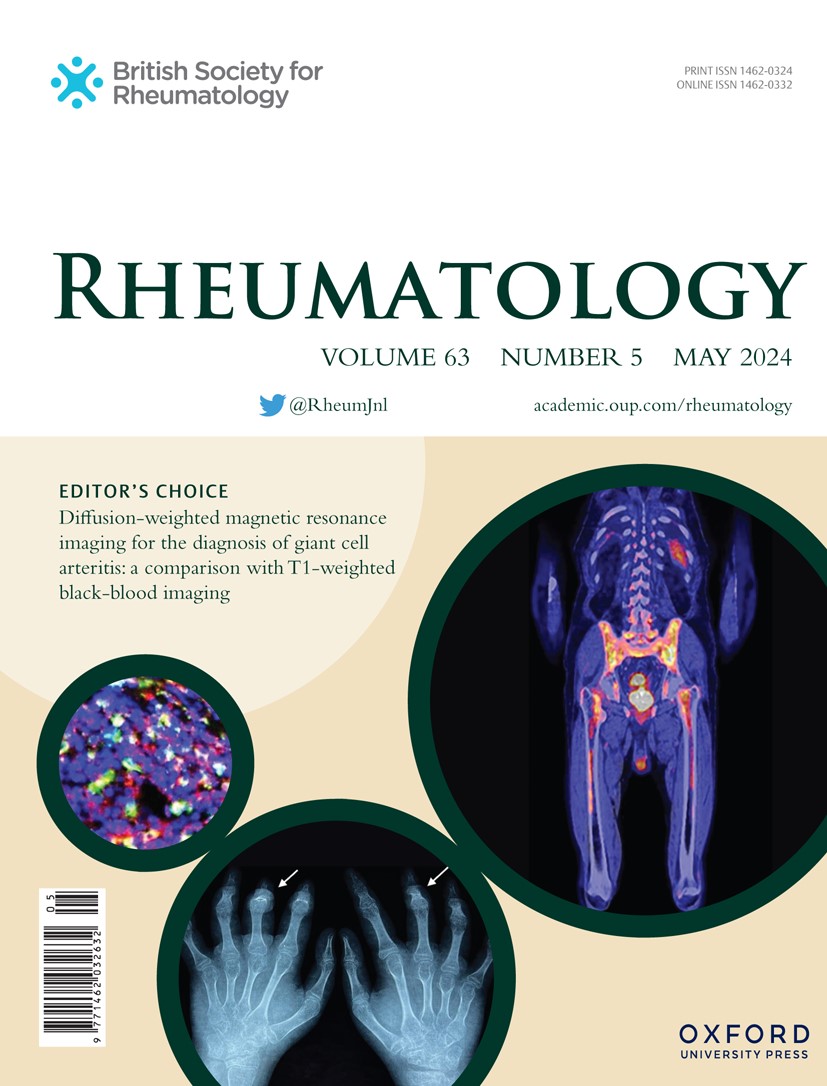Elevated pre-eclampsia risk in lupus nephritis and antiphospholipid syndrome: a nationwide Spanish registry analysis
IF 4.4
2区 医学
Q1 RHEUMATOLOGY
引用次数: 0
Abstract
Objective Evaluate the association of antiphospholipid syndrome (APS) and systemic lupus erythematosus (SLE), focusing on lupus nephritis (LN), with risk of preeclampsia (PE) and PE with severity criteria (PESC). Methods Analysis of pregnant women admitted 2016–2022 in the Spanish Hospital Discharge Database. Factors associated with PE and PESC, including early-onset PE, severe PE, eclampsia, and HELLP syndrome, were evaluated. Results Among 1,973 249 admissions, 1,787 patients had SLE (9.1‰), with prior LN in 13.2%. SLE patients experienced higher PE (5.5% vs 2.1%) and PESC (2.1% vs 0.6%) rates; these rose further in SLE women with LN alone (PE: 16.9%, PESC: 5.2%) or with both LN and APS (PE: 18.2%, PESC: 13.6%) (p< 0.05). Adjusted analyses showed PE and PESC were each associated with SLE (OR = 1.78, 95% CI 1.39–2.28; OR = 2.17, 95% CI 1.47–3.22), LN (OR = 1.94, 95% CI 1.18–3.19; OR = 2.45, 95% CI 1.18–5.09) and APS (OR = 1.53, 95% CI 1.28–1.84; OR = 1.91, 95% CI 1.44–2.54). Within SLE patients, baseline hypertension (OR = 4.27, 95% CI 2.45–7.44), LN (OR = 2.06, 95% CI 1.26–3.37) and APS (OR = 1.85, 95% CI 1.03–3.32) were linked to PE, while LN alone predicted PESC (OR = 2.88, 95% CI 1.41–5.91). Conclusion The risk of PE and PESC that patients with SLE exhibit is further amplified in those with a history of LN or APS. Recognizing SLE, APS and especially LN is crucial for precise risk stratification and tailored management to improve maternal and fetal outcomes.狼疮肾炎和抗磷脂综合征子痫前期风险升高:西班牙全国登记分析
目的评价抗磷脂综合征(APS)与系统性红斑狼疮(SLE)的相关性,重点关注狼疮肾炎(LN)与先兆子痫(PE)和PE严重程度标准(PESC)的相关性。方法对西班牙医院出院数据库2016-2022年收治的孕妇进行分析。评估与PE和PESC相关的因素,包括早发性PE、重度PE、子痫和HELLP综合征。结果在1973 249例入院患者中,1787例SLE患者(9.1‰),既往LN患者占13.2%。SLE患者PE (5.5% vs 2.1%)和PESC (2.1% vs 0.6%)发生率较高;在单独合并LN (PE: 16.9%, PESC: 5.2%)或合并LN和APS (PE: 18.2%, PESC: 13.6%)的SLE女性中,这一比例进一步上升(p< 0.05)。校正分析显示PE和PESC分别与SLE (OR = 1.78, 95% CI 1.39-2.28; OR = 2.17, 95% CI 1.47-3.22)、LN (OR = 1.94, 95% CI 1.18-3.19; OR = 2.45, 95% CI 1.18-5.09)和APS (OR = 1.53, 95% CI 1.28-1.84; OR = 1.91, 95% CI 1.44-2.54)相关。在SLE患者中,基线高血压(OR = 4.27, 95% CI 2.45-7.44)、LN (OR = 2.06, 95% CI 1.26-3.37)和APS (OR = 1.85, 95% CI 1.03-3.32)与PE相关,而LN单独预测PESC (OR = 2.88, 95% CI 1.41-5.91)。结论SLE患者出现PE和PESC的风险在有LN或APS病史的患者中进一步增加。认识到SLE、APS,尤其是LN对于精确的风险分层和量身定制的管理以改善母胎结局至关重要。
本文章由计算机程序翻译,如有差异,请以英文原文为准。
求助全文
约1分钟内获得全文
求助全文
来源期刊

Rheumatology
医学-风湿病学
CiteScore
9.40
自引率
7.30%
发文量
1091
审稿时长
2 months
期刊介绍:
Rheumatology strives to support research and discovery by publishing the highest quality original scientific papers with a focus on basic, clinical and translational research. The journal’s subject areas cover a wide range of paediatric and adult rheumatological conditions from an international perspective. It is an official journal of the British Society for Rheumatology, published by Oxford University Press.
Rheumatology publishes original articles, reviews, editorials, guidelines, concise reports, meta-analyses, original case reports, clinical vignettes, letters and matters arising from published material. The journal takes pride in serving the global rheumatology community, with a focus on high societal impact in the form of podcasts, videos and extended social media presence, and utilizing metrics such as Altmetric. Keep up to date by following the journal on Twitter @RheumJnl.
 求助内容:
求助内容: 应助结果提醒方式:
应助结果提醒方式:


